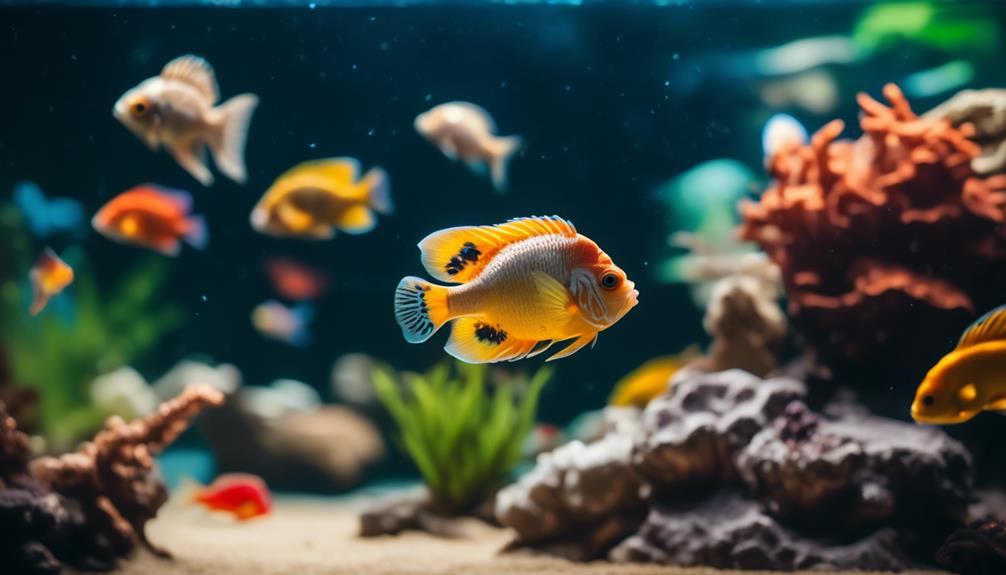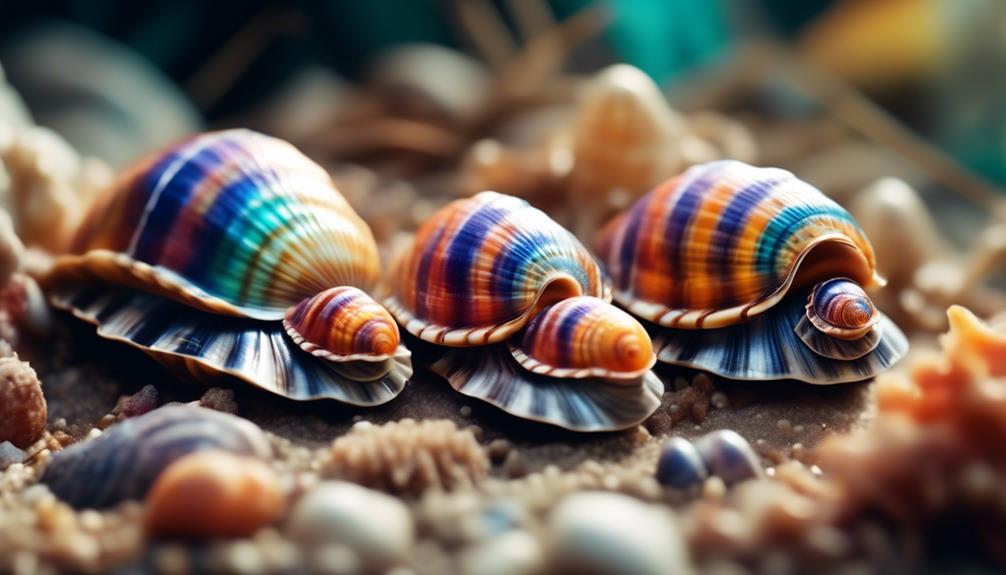The world beneath the surface of Lake Tanganyika holds an enchanting secret, hidden among the rocky shorelines and vibrant aquatic life.
Here, in this vast expanse of water, a group of small fish species known as shell dwellers have evolved to thrive in a truly unique environment.
These captivating creatures, with their fascinating behaviors and remarkable adaptations, offer a glimpse into a world that is both mysterious and awe-inspiring.
In this discussion, we will explore the intriguing world of shell dwellers, their captivating habitat, and the extraordinary characteristics that make them truly fascinating.
Get ready to embark on a journey of discovery, where every turn reveals another captivating detail about these enigmatic creatures.
Key Takeaways
- Shell dwellers are small fish that live along the rocky shorelines of Lake Tanganyika.
- Shell dwellers get their name from the snail shells they collect for breeding and shelter.
- Shell dwellers can be kept in 10-gallon aquariums or larger, depending on the species.
- Suitable tank mates for shell dwellers include African butterflyfish, livebearers, halfbeaks, smaller rainbowfish, Cyprichromis leptosoma, Neolamprologus brichardi, and Julidochromis cichlids.
Lake Tanganyika: A Unique Habitat
Lake Tanganyika, situated in the East African Rift Valley, provides a unique and captivating habitat for a diverse array of species, including the intriguing shell dwellers.
As one of the most biodiverse freshwater lakes in the world, Lake Tanganyika is considered a biodiversity hotspot, hosting a remarkable number of endemic species. The lake's geological history, characterized by tectonic activity and volcanic eruptions, has shaped its environment and contributed to the evolution of unique species adaptations.
Conservation efforts in Lake Tanganyika are crucial to preserve this invaluable ecosystem and its inhabitants. The delicate balance of the lake's ecosystem relies on maintaining water quality, protecting the shoreline habitats, and preventing overfishing.
Setting Up the Perfect Shell Dweller Aquarium
To create an optimal environment for shell dwellers, meticulous attention to detail is required in setting up their aquarium. Follow these steps to ensure the perfect shell dweller tank:
- Shell dweller tank decorations: Create a natural and visually appealing habitat by incorporating rocky structures and caves. These decorations mimic the rocky shorelines of Lake Tanganyika, providing hiding places and territories for the fish.
- Maintaining water quality for shell dwellers: Regular water changes are crucial to maintain the desired water parameters. Aim for a pH of 7.5-9.0 and hard water with at least 8° (140 ppm) GH. Use a reliable water testing kit to monitor these parameters regularly.
- Substrate selection: Choose a sand substrate like aragonite sand, which resembles the sandy bottoms of Lake Tanganyika. This substrate is essential for shell dwellers as they burrow and sift through the sand to create their territories.
- Filtration: Use a sponge filter or pre-filter sponge to cover the filter intake tube. This prevents the shell dwellers from getting sucked into the filter and provides a gentle flow of water that mimics their natural habitat.
Choosing Compatible Tank Mates for Shell Dwellers

Shell dwellers require tank mates that can tolerate the alkaline and mineral-rich waters of Lake Tanganyika and coexist peacefully in their semi-aggressive nature. When choosing tank mates for shell dwellers, it is important to consider their compatibility to create a harmonious shell dweller community.
Suitable tank mates include African butterflyfish, livebearers, halfbeaks, smaller rainbowfish, Cyprichromis leptosoma, Neolamprologus brichardi, and Julidochromis cichlids. These species can thrive in the same water conditions and are less likely to disturb the shell dwellers' territories.
However, it is advisable to provide separate territories for rock-dwelling Julidochromis cichlids to prevent conflicts.
Feeding the Fascinating Shell Dwellers
The feeding habits of shell dwellers are a fascinating aspect of their behavior, revealing their adaptability and unique dietary requirements. Understanding their nutritional needs is crucial for keeping these fish healthy and thriving in an aquarium setting.
Here are four important points about the feeding habits and nutritional requirements of shell dwellers:
- Varied Diet: In the wild, shell dwellers feed on zooplankton, small invertebrates, and other microorganisms. To replicate their natural diet, it is best to offer a varied diet in captivity. This can include crushed flakes, nano pellets, baby brine shrimp, micro worms, white worms, and frozen bloodworms.
- Surface Feeders: Adult shell dwellers come to the surface for their meals. It is important to provide floating or sinking foods that they can easily access. Fry, on the other hand, wait near their shells for sinking foods.
- Compatibility with Snails: Contrary to popular belief, shell dwellers do not eat snails. Therefore, Malaysian trumpet snails, bladder snails, and nerite snails can be safely kept with shell dwellers without any problems.
- High Protein Content: Shell dwellers have high protein requirements, especially during breeding. It is essential to provide them with protein-rich foods to support their reproductive success and overall health.
Breeding Shell Dwellers: A Natural Wonder

Feeding the fascinating shell dwellers reveals only a fraction of their intricate behaviors, as their ability to reproduce and raise their young showcases the captivating natural wonder of these unique fish. Shell dwellers exhibit interesting breeding behaviors and techniques that contribute to their survival in Lake Tanganyika. To convey a deeper understanding of their breeding habits, the following table summarizes the key aspects of shell dweller behavior and breeding techniques:
| Shell Dweller Behavior | Shell Dweller Breeding Techniques |
|---|---|
| Males guard territories | Females lay eggs in shells |
| Males display impressive aggression | Males fertilize eggs and guard them |
| Fry stay close to shell opening | Fry feed on microscopic organisms |
| Juveniles explore further as they grow | Mother displaces juveniles to make room |
| Mother's reproductive cycle repeats | High food availability and water quality essential |
Understanding these breeding techniques provides insight into the delicate balance of nature that allows shell dwellers to thrive in their unique environment. From the protection of territories to the careful care of fry, shell dwellers showcase the wonders of natural adaptation and reproduction.
Frequently Asked Questions
How Long Do Shell Dwellers Typically Live in Captivity?
The lifespan of shell dwellers in captivity can vary depending on various factors. However, with proper care and optimal conditions, shell dwellers can live for several years, with some species known to live up to 8-10 years. Factors affecting their longevity include water quality, diet, genetics, and overall health.
Are Shell Dwellers Prone to Any Specific Diseases or Health Issues?
Shell dwellers are generally hardy fish, but they can be prone to certain diseases such as bloat, fin rot, and ich. Providing a proper diet with varied foods can help boost their immune system and prevent health issues.
Can Shell Dwellers Be Kept in a Community Tank With Other Types of Cichlids?
Shell dwellers can be kept in a community tank with compatible cichlids such as African butterflyfish, livebearers, halfbeaks, smaller rainbowfish, Cyprichromis leptosoma, Neolamprologus brichardi, and Julidochromis cichlids. However, separate territories should be provided for rock-dwelling Julidochromis cichlids to minimize aggression.
What Is the Ideal Water Flow Rate for a Shell Dweller Aquarium?
The ideal water flow rate for a shell dweller aquarium depends on the specific species and their natural habitat. Shell dwellers prefer low to moderate water flow, replicating the calm waters of Lake Tanganyika.
Are There Any Specific Water Parameters That Need to Be Maintained During the Breeding Process?
Breeding shell dwellers requires optimal water conditions to ensure successful reproduction. Maintaining stable water parameters, such as temperature (75-80°F), pH (7.5-9.0), and hard water with at least 8° GH, is vital for the breeding process.
Conclusion
In conclusion, the world of shell dwellers in Lake Tanganyika is a captivating and unique one. These fish species have adapted to the alkaline environment and tropical temperatures, utilizing snail shells for breeding and shelter.
By setting up the ideal aquarium, choosing compatible tank mates, and providing proper feeding techniques, we can observe and appreciate the fascinating behaviors of these remarkable creatures.
Exploring the wonders of shell dwellers is like embarking on a journey into a mesmerizing underwater world.

